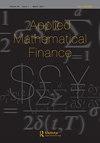Limit Order Books, Diffusion Approximations and Reflected SPDEs: From Microscopic to Macroscopic Models
Q3 Mathematics
引用次数: 10
Abstract
ABSTRACT Motivated by a zero-intelligence approach, the aim of this paper is to connect the microscopic (discrete price and volume), mesoscopic (discrete price and continuous volume) and macroscopic (continuous price and volume) frameworks for the modelling of limit order books, with a view to providing a natural probabilistic description of their behaviour in a high- to ultra high-frequency setting. Starting with a microscopic framework, we first examine the limiting behaviour of the order book process when order arrival and cancellation rates are sent to infinity and when volumes are considered to be of infinitesimal size. We then consider the transition between this mesoscopic model and a macroscopic model for the limit order book, obtained by letting the tick size tend to zero. The macroscopic limit can then be described using reflected SPDEs which typically arise in stochastic interface models. We then use financial data to discuss a possible calibration procedure for the model and illustrate numerically how it can reproduce observed behaviour of prices. This could then be used as a market simulator for short-term price prediction or for testing optimal execution strategies.限制订单书,扩散近似和反映的spde:从微观到宏观模型
在零智能方法的激励下,本文的目的是将微观(离散价格和成交量),介观(离散价格和连续成交量)和宏观(连续价格和成交量)框架连接起来,用于限价订单的建模,以期提供其在高至超高频设置下的行为的自然概率描述。从微观框架开始,我们首先检查当订单到达率和取消率被发送到无穷小以及当体积被认为是无穷小的尺寸时,订单簿过程的极限行为。然后,我们考虑这种介观模型和极限订单簿的宏观模型之间的过渡,通过让刻度大小趋于零而获得。然后可以使用反射spde来描述宏观极限,这通常出现在随机界面模型中。然后,我们使用财务数据来讨论模型的可能校准程序,并说明数值如何再现观察到的价格行为。然后,这可以用作短期价格预测或测试最佳执行策略的市场模拟器。
本文章由计算机程序翻译,如有差异,请以英文原文为准。
求助全文
约1分钟内获得全文
求助全文
来源期刊

Applied Mathematical Finance
Economics, Econometrics and Finance-Finance
CiteScore
2.30
自引率
0.00%
发文量
6
期刊介绍:
The journal encourages the confident use of applied mathematics and mathematical modelling in finance. The journal publishes papers on the following: •modelling of financial and economic primitives (interest rates, asset prices etc); •modelling market behaviour; •modelling market imperfections; •pricing of financial derivative securities; •hedging strategies; •numerical methods; •financial engineering.
 求助内容:
求助内容: 应助结果提醒方式:
应助结果提醒方式:


